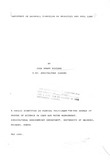| dc.contributor.author | Boateng, JK | |
| dc.date.accessioned | 2013-05-30T06:04:07Z | |
| dc.date.available | 2013-05-30T06:04:07Z | |
| dc.date.issued | 1994 | |
| dc.identifier.citation | Master of science in land and water management | en |
| dc.identifier.uri | http://erepository.uonbi.ac.ke:8080/xmlui/handle/123456789/27254 | |
| dc.description.abstract | A study was carried out to determine the directional impact of
rainfall on erosivity and soil loss in the Kabete area of Nairobi.
This was done by employing three major fields of data collection :
(1) Wind monitoring using a wind recorder. (2) Rainfall monitoring
using a rain recorder and three sets of raingauges, each set
consisting of five gauges facing different directions and (3)
Runoff and soil loss monitoring on twenty-four microplots of size
1x2m and oriented to face four different compass directions. The
four compass directions used were NE, SE, NW and SW.
The following erosivity indices: ElalI30' EusdaI30' E1a1 and AI30
were the best indices found to describe runoff erosion in the
Kabete area. There was no significant difference in their ability
to describe runoff erosion. Hence any of the four can be used for
this region. Rainfall dominantly from westerly directions was
found to have a significant directional effect over that of
easterly and even vertical rainfall. This observation makes
inclined gauges really better to use for erosivity predictions than
vertical gauges. Slopes facing westerly directions suffered more
soil loss, thus were more prone to damage than those facing
easterly directions. Conservation planning should focus more
attention to westerly facing slopes in this region. | en |
| dc.language.iso | en | en |
| dc.title | Influence of rainfall direction on erosivity and soil loss | en |
| dc.type | Thesis | en |
| local.publisher | Department of Agricultural Engineering | en |

